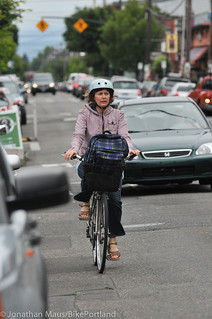Tara Goddard, a PhD candidate in Urban Studies at Portland State University (PSU), is devoting her thesis to a subject that gets a lot of traction in the media but so far has received scant attention in academia: road rage between people who drive and people who bike.
According to Goddard, her research will focus on the “interactions between drivers and bicyclists,” an aspect of “transportation psychology” research that is largely untapped (most major studies have focused on driver-to-driver rage). Goddard plans to delve into the mechanisms and predictors of driver-rider road rage. “For example, as drivers, we experience (and sometimes perpetrate) law-bending/breaking all the time,” she shared via email. “It is socially acceptable, in many ways. But any scofflaw behavior on the part of a bicyclist suddenly condemns the entire bicycling world.”
Why does that happen? Goddard has a few hunches:
“One likely reason is the view of a bicyclist as a very visible “other,” which stereotype theory tells us makes us want to justify our “in-group” (in this case, cars and drivers,) and vilify the “out-group” (like bicyclists). Another explanation is social dominance theory – a bicyclist represents not just a person in that instance, but a threat to the norm of driving (or driving as a “right,”), and thus the desire to vilify it. The whole “bicyclists don’t pay taxes” argument helps bolster the social dominance idea.”
Another phenomenon Goddard plans to analyze is the psychological concept of “deindividuation” — the loss of feeling like an individual when in a group (Tom Vanderbilt, an author and major inspiration for Goddard’s research, wrote about this concept in his groundbreaking book, Traffic (2008)). Deindividuation, says Goddard, results in a lack of inhibition. “At the extreme, think mob mentality. The relative anonymity and perceived protection (social, not physical) of our cars can can lead to behaviors we would never think acceptable in almost any other situation.”
“Can you imagine tail-gating someone at the grocery store with your cart? Or yelling at someone that vegetarians should stick to the produce aisle? I believe this deindividuation also plays into the reporting of crashes — the whole “a van hit a pedestrian” problem,” says Goddard.
“Before we can fairly tell people to “share the road,” we need to understand why it is that we currently don’t.”
— Tara Goddard
Adding another interesting layer to Goddard’s research will be taking what’s known about why road rage happens and applying it across different types of bike riders. “In the eyes of drivers, not all bicyclists are the same,” says Goddard, “and this leads to different, potentially dangerous behaviors like reduced passing distance (Goddard will look to build on research by Ian Walker). Going further, Goddard will even consider how the appearance, gender and race of a person riding a bike plays into how people behave behind the wheel.

(Photo: James Newman)
Why does this type of research matter? Goddard sees road rage — whether just the fear of being a victim, or actually experiencing it — as a deterrent to bicycling. “We experience many micro-aggressions from other drivers when in our cars, but we keep on driving. But one or two bad experiences as a bicyclist or pedestrian, when the mass/speed/power differential is so big, and we may not walk or bicycle again, if we can avoid it.” She feels some of the gender gap in bicycling is a direct result of women being more likely to be “conflict-averse and more cognizant of being endangered.” Goddard says women aren’t necessarily afraid of riding in traffic in general, but that it’s the aggression from people inside the cars that scares them.
If cities and engineers understood what spurs certain people to lash out against other road users, only then, Goddard feels, can we figure out which type of interventions might mitigate those behaviors and improve road safety for everyone:
“We know that interactions between drivers and bicyclists are sometimes, even frequently, negative. The anecdotal evidence is extensive. Yet we do not have a good understanding of the social and psychological processes that explain the relations between drivers and bicyclists, and what that might suggest about infrastructure or programmatic solutions to improve those relations. But before we can fairly tell people to “share the road,” we need to understand why it is that we currently don’t.”
We’re looking forward to Goddard’s work because she isn’t your typical graduate student. Before moving to Portland in 2011, Goddard was the bicycle/pedestrian coordinator for the City of Davis (California) for four years. She also holds a Masters in Civil Engineering from the University of California, Davis and a Bachelors in Mechanical and Environmental Engineering from UC Santa Barbara. Goddard’s mix of real-world experience, training as an engineer, and education from PSU’s vaunted urban studies program could produce some very important work.
Follow Goddard on Twitter at @GoddardTara.


